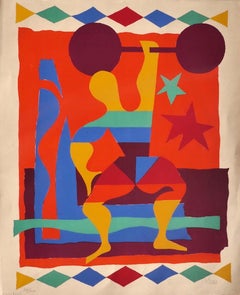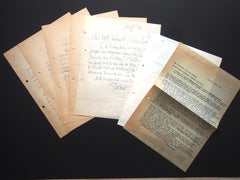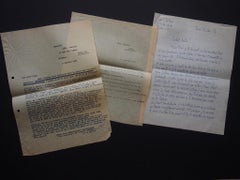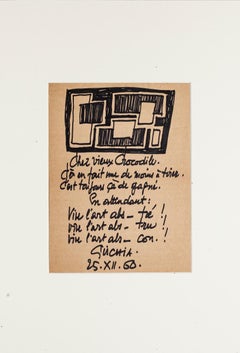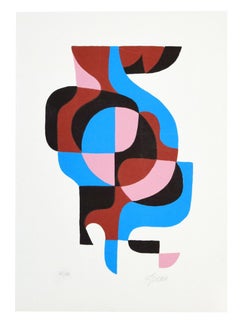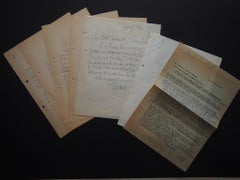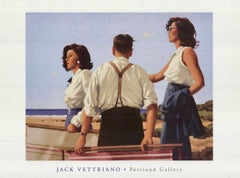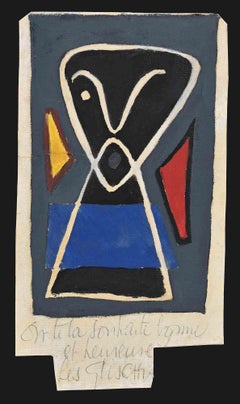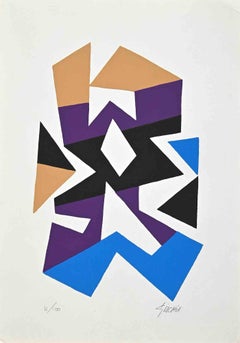Léon Gischia Art
Born in the ancient market town of Dax, not far from coastal Biarritz, in southwestern France, Léon Gischia moved to Paris in the early 1920s, where he studied under the French artist Ferdinand Léger in his Montparnasse studio. Alongside artists Amédée Ozenfant and Le Corbusier, Ferdinand Léger was a principal exponent of the Purist movement. Purism’s unique fusion of figurative representation with vibrant Cubism would prove a lifelong influence upon the work of Léon Gischia.
As part of the International Exhibition in Paris, over the summer of 1937, Gischia collaborated with his former-teacher Léger on Le Corbusier’s radical designs for the Pavillon des Temps Nouveaux. A huge tent erected outside the main grounds of the exhibition — and described by a critic of the day as “the most exciting, convincing and easily remembered” — they expressed their vision of an ‘ideal city’ of the future. Fast gaining a significant artistic reputation, Gischia was recognised by influential Parisian art dealer and publisher Jeanne Bucher. His first solo exhibition took place in March 1938 at Bucher’s Montparnasse gallery, and amid garnering critical acclaim, his artistic debut was followed in 1939 by an exhibition at Galerie Alfred Poyet — just north of the Élysée Palace — in the 8th arrondissement of Paris.
After the outbreak of the Second World War and the Nazi invasion in June 1940, Gischia remained in Paris and resolutely resisted the “degenerate” label applied to his work. Along with other artists from the “underground” avant-garde, Gischia successfully exhibited and sold his inventive work throughout the war in “back rooms” at the Galerie Braun and the Galerie de France. Alongside Gischia’s poetic sensibilities and sumptuous work, his wartime stoicism would consolidate his later position as an influential voice of the “School of Paris” group.
Gischia’s fruitful post-war relationship with the Galerie Billiet-Caputo — a stone’s throw from the Galerie Alfred Poyet, for which he exhibited before the war — resulted in his representing France at the 1948 Venice Biennale. This secured his international reputation, and soon, he was exhibiting in private galleries across the world. During the 1950s, Gischia even designed costumes and sets for the Theatre National Populaire in Paris, later writing well-regarded books on sculpture and so-called “primitive art.” Today his work features in public collections throughout Europe and the United States, and during the 1980s — before his death in Venice — Gischia enjoyed numerous internationally acclaimed retrospective exhibitions.
(Biography provided by Stern Pissarro Gallery)
Late 20th Century Léon Gischia Art
Lithograph
1960s Surrealist Léon Gischia Art
Permanent Marker
1950s Modern Léon Gischia Art
Paper, Ink
20th Century Contemporary Léon Gischia Art
Cardboard, Pen
Late 20th Century Abstract Léon Gischia Art
Screen
1960s Modern Léon Gischia Art
Paper, Ink
1960s Surrealist Léon Gischia Art
Permanent Marker
1960s Surrealist Léon Gischia Art
Permanent Marker
Early 2000s Contemporary Léon Gischia Art
Lithograph, Offset
2010s Other Art Style Léon Gischia Art
Lithograph
1970s Abstract Léon Gischia Art
Screen, Parchment Paper
1970s Abstract Geometric Léon Gischia Art
Screen
1960s Abstract Geometric Léon Gischia Art
Screen
Early 2000s Abstract Geometric Léon Gischia Art
Ink, Permanent Marker, Lithograph, Offset
1970s Abstract Léon Gischia Art
Screen
1980s Abstract Léon Gischia Art
Screen
1970s Abstract Geometric Léon Gischia Art
Screen
1960s Abstract Geometric Léon Gischia Art
Screen
1960s Surrealist Léon Gischia Art
Lithograph
21st Century and Contemporary Surrealist Léon Gischia Art
Digital
1960s Abstract Léon Gischia Art
Tempera
1970s Abstract Léon Gischia Art
Screen
Late 20th Century Abstract Léon Gischia Art
Screen
Late 20th Century Abstract Léon Gischia Art
Screen
